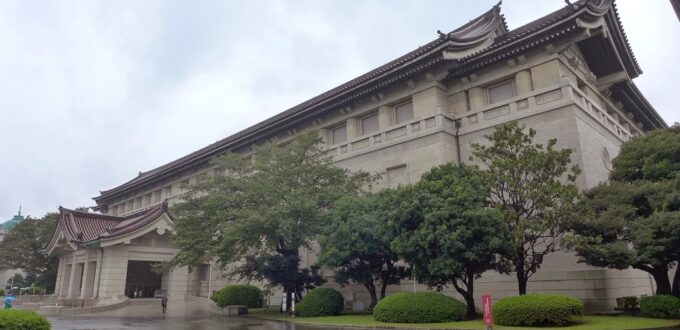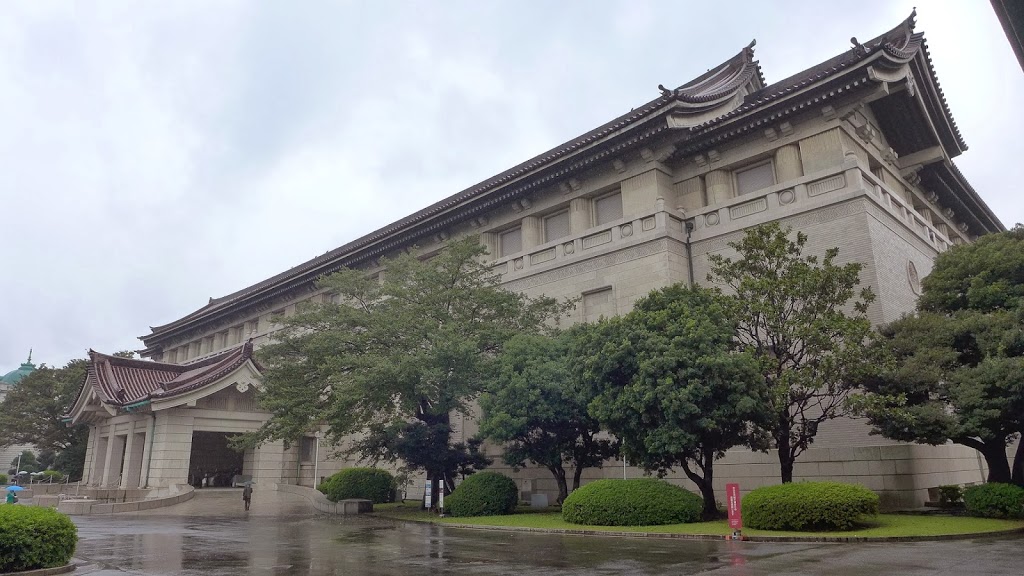
 |
| Tokyo Metropolitan Museum, main building |
Today it’s meant to be even more rainy. A typhoon hit the city, bringing a fair bit of rain and wind up to 30km/h. It’s a weak one, but by those standards there is a weak typhoon twice a week in Edinburgh. The weather was perfect for a museum day, so we took the metro to Tokyo National Museum in the Ueno park.
 |
| A clever umbrella storage |
A quick note: communication in Tokyo is both great and awkward. Great, because the SUICA card works not only as a metro ticket, but can also be used on buses, trains, in vending machines, locker boxes and in some shops. Even better, it works almost everywhere in Japan. Awkward, because the trains and metro have been built by several separate companies and the stations just don’t always connect – trains going in one direction leave from one station, and if you want to go elsewhere, you need to walk to the other company’s station.
 |
| Ueno park |
 |
| Shinto temple |
The museum was great and most instructive. The Japanese culture really is different and it’s amazing to learn why. Some observations: Japan has always been very nationalistic and it is still now – there are hardly any gaijin on the streets, and they aren’t treated well. Japanese can be written in three different alphabets, kanji, hiragana and katakana, and everything you write can be read in several different ways – this makes haiku awesome, and translations horrible. The Japanese love form and presentation above all – the packaging is more important than the content, both in art and in life. Since language is so important, letters and poems are framed in paper like paintings and displayed. The perspective in pictorial representations is isometric and already in 13th century paintings you can see the Japanese love for straight angles – their modern cities are built on a grid, but so were the medieval ones. Unlike in other cultures, Japanese art doesn’t represent their gods – most isn’t religious at all and the sculptures that are, are all Buddhist, not Shinto. There is virtually no nakedness in any representations, neither male nor female.
 |
| And one more Shinto temple |
We spent most of the day in the museums and had lunch in the museum cafe – lots of raw and cooked fish and roe on rice. In the meantime it stopped raining and the park filled with people. We strolled about, feet hurting horribly after the whole day of standing, still jetlagged, and since all interesting temples in the area closed at 4:30, we decided to go home. On the way we went to a shop and bought some mystery food for dinner – still don’t know what it all was, but it had a lot to do with seaweed, pancakes, pastry shaped like little bags, and some weird blobs that Eva decided tasted like licking Cthulhu’s armpits. Fun! Some more essay marking (BTW, blame my students for the delays with posting this journal, I simp
ly didn’t have time to write before), and then more jetlag surprises: this time can’t fall asleep. Eh…
Some assorted observations time!
 |
| Tokyo by night |
99% of men wear suits. Pretty well cut ones, but damn is it boring! They all look like corporate ants, dressed the same, going to lunch at the same time…
There are hardly any parks in town, and most of those that exist consist of some trees, a little grass, and a lot of asphalt. Also, there are very few public spaces where you can sit: squares, benches, boulevards.
There are many people. Many, many people. 13mln live here, and the population density is 6000/km2. Edinburgh has 1800/km2…
 |
| Mystery food… |
It’s a cyclist heaven. Bicycles are allowed to do anything, ride on pavement, cross red lights… Great stuff.



qm17zr